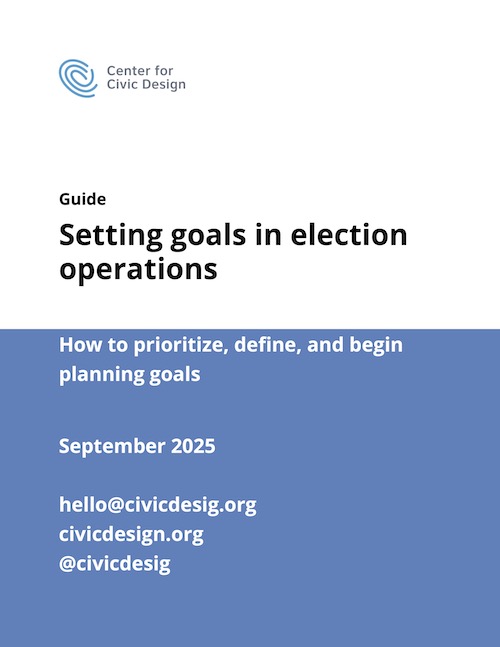Turning ideas into action: a new toolkit for goal setting in election operations
After an election cycle, your office likely ends up a long list of ideas for how to improve the next one.
Maybe the voter signage caused confusion. Maybe the check-in process slowed things down. Or maybe your office communication could run more smoothly.
The insights that come after running an election, and the energy that comes right after an election, are invaluable. But turning them into concrete, achievable goals requires structure, collaboration.
Over the past year, we’ve been developing systems to help election officials do just that.
Last year, we released the first step in this series: a toolkit to help offices reflect on what worked and what could improve: the Post-election debrief toolkit.
Now, we’re excited to share the second part of the series: Setting goals in election operations, a practical guide to help election offices move from reflection to action.

Setting goals in election operations
The Setting goals in election operations toolkit includes 3 parts:
Section 1. Setting goals in election operations
Section 2. The goal setting worksheet
Section 3. The goal setting template
Closing the gap: a step-by-step guide to move from ideas to action
The setting goals in election operations toolkit is designed to take you from “we should do this next time” to “here’s exactly how we’ll do it.”
It walks you through:
- Turning notes into actionable ideas
- Choosing which ideas to move forward with
- Defining your goals clearly
- Creating preliminary plans for how to achieve them
This toolkit builds directly on your debrief, helping your team identify priorities that will make the biggest difference for your voters and staff and build momentum for meaningful improvement.
It’s meant to be done immediately after the election, while the ideas are still fresh in your team’s minds.
What’s inside the toolkit
- The guide: The guide outlines the process for defining and planning realistic goals. It includes examples and considerations to help you prioritize ideas and start forming the foundation for action.
- The worksheet: The worksheet turns ideas into concrete, SMART goals. It’s a structured way to capture your top ideas, assess them against your office’s values, and outline what success looks like. By the end, you’ll have a set of defined goals ready to move forward.
- The template: The Miro template is an optional digital whiteboard that helps teams visually sort and prioritize ideas. It’s designed for collaboration — a shared space to spot patterns, group ideas, and make decisions together before writing formal goals.
What election offices are saying about the goal setting process
In the most recent cohort of the U.S. Alliance for Election Excellence, election offices found using this process made goal setting more manageable. For example, one office in the cohort focused on voter registration used it to establish internal office procedures for voter list maintenance.
“The process was easy in assisting us to identify and streamline achievable goals in a manageable, realistic time frame while using very little or no resources.”
Another office used the goal setting process to create an online portion of poll worker training. They noted how the process created space for collaboration and creativity:
“We enjoyed getting together as a staff and exchanging different ideas; we all had different thoughts and opinions, and it was very fun talking everything out! We learned that we need to be more expansive in our answers and thoroughly lay out our steps and plans.”
For another office, putting goals on paper made all the difference:
“I found it helpful to actually set a goal and put it on a timeline. We have been saying for more than a year that we would like to address this issue. I believe writing it down will help us maintain focus.”
Visual tools for prioritizing what matters most
An important part of setting goals is deciding which ideas are worth pursuing right now and which can wait.
Our visual matrices help you lay all your ideas out on different axes and have productive conversations about priorities.
Once you have a chance to map the ideas visually, it’ll be much easier to actually sort through your ideas systematically and make decisions as a team about which ones to pursue.
For example, the matrices include:
- Impact–time sensitivity matrix:
Helps identify which ideas should be worked on first versus those that can be addressed later. For example, tasks in the “Do now” quadrant are both high impact and time-sensitive, while “Do later” ideas may be lower urgency but still valuable for long-term success. - Impact–effort matrix:
Encourages teams to think strategically about capacity. “Quick wins” are ideas that are easy to implement and yield strong results, which are ideal for early momentum. “Big projects” may require more planning and resources but lead to greater long-term impact. - Cost–impact matrix:
Supports budgeting and resource allocation. It helps offices recognize which ideas are high impact but may need funding (“Investments”), and which can deliver results within existing budgets (“Quick wins”).

How to get started
The Setting goals in election operations toolkit is meant to be completed right after an election cycle following the post election debrief toolkit, but you can use it any time you are trying to plan ambiguous or lofty ideas.
We recommend using it to facilitate workshops with your whole team. The whole process should take 1 day to complete.
Reach out to us at hello@civicdesign.org with any questions you have along the way or if you would like hands-on support in the process.

